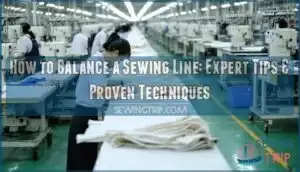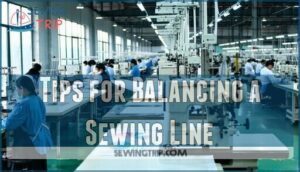This site is supported by our readers. We may earn a commission, at no cost to you, if you purchase through links.

Redistribute complex tasks to faster operators, add capacity at chokepoints, or break down multi-step operations. Use real-time monitoring to track efficiency—aim for 60-80% line efficiency by matching each station’s output to your target cycle time.
Deploy skilled floaters to address immediate imbalances, and maintain 4-12 days of work-in-progress inventory. The secret lies in treating your line like a synchronized system where every station moves at the perfect rhythm.
Table Of Contents
Key Takeaways
- Map your bottlenecks first – Identify where work piles up by tracking each workstation’s cycle time, then redistribute complex tasks to faster operators or add capacity at chokepoints to maintain a smooth flow.
- Use real-time monitoring for dynamic adjustments – Deploy skilled floaters and track efficiency metrics continuously so you can address imbalances immediately rather than waiting for problems to compound.
- Target 60-80% line efficiency – Calculate your efficiency by dividing the total standard minutes produced by the total operator minutes attended, then multiply by 100 to get a realistic benchmark for your operation.
- Control WIP inventory strategically – Maintain 4-12 days of work-in-progress through daily tracking and bottleneck identification to prevent workflow chaos and keep your balanced line running smoothly.
Types of Line Balancing
You’ll encounter two main approaches when balancing your sewing line: static and dynamic methods. Each serves different production needs and requires specific implementation strategies to optimize workflow efficiency.
Static Line Balance
Static line balance acts as your production foundation, where you’ll assign operations in a fixed sequence for predictable workloads. This systematic approach guarantees consistent task assignment and workload distribution across your sewing line. You’ll establish predetermined workflows that maintain steady production planning without constant adjustments.
- Map operation sequences – Create detailed task assignment charts showing each step
- Calculate standard times – Use efficiency metrics to determine realistic completion rates
- Balance workstation capacity – Distribute tasks evenly to prevent bottlenecks
- Document procedures – Maintain clear guidelines for line optimization consistency
- Monitor performance – Track sewing line efficiency against established benchmarks
Dynamic Line Balance
Dynamic line balance transforms your sewing operation by continuously adjusting operator allocation and workload distribution in real time. Unlike fixed systems, you’ll monitor bottleneck management through real-time monitoring tools that track each workstation’s performance. This approach optimizes sewing line efficiency by redistributing tasks based on current conditions.
Real-time adjustments keep your sewing line flowing smoothly, eliminating bottlenecks before they disrupt production
Skilled floaters address immediate bottlenecks while efficiency optimization algorithms suggest resource adjustments. These line balancing techniques guarantee your production stays balanced despite changing demands, operator absences, or equipment issues, maximizing overall productivity.
Effective thread tension adjustment is vital for achieving superior sewing results and maintaining equipment performance.
How to Automate or Digitalize Line Balance in Garment Industry?
Building on traditional line balancing methods, modern garment manufacturers can now harness cutting-edge technology to transform their operations. AI Implementation and Machine Learning algorithms analyze production data in real-time, automatically adjusting operator assignments when bottlenecks emerge. This smart approach eliminates the guesswork that often plagues manual balancing decisions.
Digital Tools integrated with IoT systems provide instant visibility into each workstation’s performance. You’ll receive alerts when operators fall behind or machines experience delays, enabling quick corrective action. Companies using these systems report efficiency gains of up to 8.63% compared to traditional methods. By utilizing AI powered solutions, manufacturers can optimize production lines and improve overall efficiency.
Here are two proven Automation Strategies for immediate implementation:
- Real-time monitoring systems that track individual operator output through RFID or automated counters, delivering instant performance data to supervisors.
- AI-powered task scheduling that reduces unnecessary operator movement and improves throughput by up to 8% through intelligent workflow optimization.
Industry 4.0 technologies like digital twin platforms let you test different balancing scenarios virtually before implementing changes on your actual production floor, ensuring ideal results without costly trial-and-error approaches.
How to Calculate Sewing Line Efficiency?
Now that you’ve streamlined your line balance with digital tools, you’ll want to measure how well your efforts are paying off. Calculating sewing line efficiency gives you the hard numbers to prove your improvements are working.
Numbers don’t lie—measuring efficiency proves your line balancing efforts are actually working
Sewing Line Efficiency reveals whether your production line is hitting its potential or falling short. The formula is straightforward: divide your total standard minutes produced by total operator minutes attended, then multiply by 100. Here’s what you need to track:
- Total standard minutes produced – Multiply your output pieces by the garment’s SAM (Standard Allowed Minute)
- Total operator minutes attended – Number of operators × working hours × 60
- Efficiency percentage – Apply the formula to get your baseline metric
Your Efficiency Metrics should include Cycle Time, Throughput Rate, and Utilization Rate. These Production Planning indicators help you spot bottlenecks before they derail your Production Efficiency goals. Remember, achieving 60-80% efficiency is realistic for most operations through consistent Line Balancing practices. To improve overall productivity, monitoring and analyzing operator efficiency regularly is necessary.
How to Control WIP in Sewing Line?
Now that you’ve calculated your sewing line efficiency, you’ll want to tackle the next challenge: controlling Work In Progress levels. Excessive work-in-progress creates chaos, blocks workflow, and destroys your carefully balanced line.
Here are three proven strategies for Work-In-Progress Management:
1. Real-Time Inventory Management:
Track materials and components at each workstation using digital systems. Daily WIP reports reveal problem areas before they spiral out of control, helping you maintain ideal inventory levels.
2. Bottleneck Identification:
Monitor production flow to spot where garments pile up. Method studies at high-WIP operations typically return actionable improvements. Redistribute workload or add temporary capacity to clear these chokepoints.
3. Production Scheduling Optimization:
Set realistic daily WIP targets aligned with your output goals. Pre-production planning prevents excess buildup by matching manpower requirements to style complexity.
- Pro tip: Well-managed factories maintain 4-12 days of WIP inventory—anything beyond this range signals Manufacturing Logistics problems requiring immediate Supply Chain Optimization adjustments.
Effective use of Sewing Line Software can substantially improve production efficiency.
Smart Line Balancing keeps Production Efficiency flowing smoothly without costly bottlenecks.
How to Improve Sewing Line Efficiency?
Maximizing sewing line efficiency requires strategic focus on three core areas that directly impact your production rate. You’ll see immediate results when you align operator capabilities with workload demands and eliminate process waste.
1. Operator Training:
Invest in thorough skill development programs that enhance operator versatility. Cross-trained workers can seamlessly move between stations, preventing bottlenecks when absences occur. This flexibility is vital for maintaining consistent production flow.
2. Workflow Optimization:
Analyze your current process to identify inefficiencies. Map each operation’s cycle time and eliminate non-value-added activities. Streamlined workflows reduce handling time and minimize work-in-process inventory accumulation.
3. Equipment Maintenance:
Implement preventive maintenance schedules to avoid unexpected downtime. Well-maintained machinery operates at peak speed and produces consistent quality, directly supporting your garment production optimization goals.
- Performance Metrics Tracking: Monitor key indicators like throughput rate, operator utilization, and defect rates hourly to enable immediate corrective actions.
To further enhance production, understanding sewing line efficiency is essential for achieving optimal results. Continuous improvement through systematic line balancing transforms your production efficiency from reactive management to proactive control.
Tips for Balancing a Sewing Line
Achieving ideal sewing line balance requires implementing proven strategies that maximize productivity while maintaining quality standards. Once you’ve improved your overall efficiency metrics, focus on these practical line balancing techniques that deliver measurable results.
Smart operator training transforms your production floor by developing cross-functional skills that support dynamic line balance. When operators master multiple operations, you gain flexibility to redistribute workload during bottlenecks or absences. This workforce adaptability prevents production delays and maintains consistent output levels.
Here are three essential tips for effective line balancing:
- Implement skill matrix mapping to match operator capabilities with specific operations, ensuring ideal placement and utilization during workstation optimization
- Deploy strategic floaters who can address bottlenecks quickly and fill gaps, enhancing production planning flexibility and resource utilization
- Monitor efficiency metrics continuously using real-time dashboards and line monitoring systems to detect imbalances before they impact productivity
These sewing line efficiency strategies create sustainable improvements in your manufacturing processes. By combining proper operator training with smart production planning, you’ll achieve better throughput while reducing waste and maintaining quality standards throughout your operations.
Frequently Asked Questions (FAQs)
What causes bottlenecks in sewing production lines?
Bottlenecks occur when you’ve got uneven operator skills, outdated time standards, machine breakdowns, poor material flow, or inadequate workforce allocation.
These choke points create production jams that’ll slow your entire line down.
How do skill levels affect line balancing?
Picture mismatched gears grinding against each other—that’s what happens when you ignore operator skill levels in line balancing.
You’ll want to map each worker’s capabilities using a skill matrix, then strategically place your strongest performers at bottleneck operations while distributing tasks based on competency levels to maintain smooth production flow.
What equipment maintenance impacts line balance?
Regular equipment maintenance directly affects your line balance by preventing unexpected breakdowns that create bottlenecks.
You’ll maintain consistent production rates when machines run smoothly, avoiding the ripple effects of downtime across workstations, which is crucial for maintaining consistent production rates.
How does fabric type influence balancing decisions?
Think you’re a fabric whisperer? Different fabrics dramatically affect your line balancing decisions.
Lightweight fabrics need gentler handling, requiring slower operations and different skill sets.
Heavy materials demand stronger operators and adjusted cycle times for maximum efficiency, which involves line balancing decisions.
When should floaters be repositioned during shifts?
Reposition floaters when bottlenecks persist despite initial interventions, absenteeism creates gaps, or real-time data shows uneven workflow distribution.
Move them during natural break points to minimize disruption and maintain production rhythm.
Conclusion
Rome wasn’t built in a day"—neither is perfect line balancing. Master how to balance a sewing line through systematic analysis, strategic task redistribution, and continuous monitoring.
You’ve learned to identify bottlenecks, calculate efficiency ratios, and implement dynamic balancing techniques. Success depends on treating your production line as an integrated system where every workstation synchronizes perfectly.
Apply these proven methods consistently, and you’ll achieve ideal flow, reduced WIP, and sustained 60-80% line efficiency that keeps your operation competitive.
- https://medcraveonline.com/JTEFT/integration-of-digital-lean-principles-and-line-balancing-in-apparel-manufacturing.html
- https://sciendo.com/article/10.2478/ftee-2025-0002
- https://kingslakeblue.com/benefits-of-ai-powered-line-balancing/
- https://www.linkedin.com/pulse/sewing-line-balancing-how-low-data-productivity-risk-wrong-brinkhoff
- http://ieomsociety.org/bogota2017/papers/56.pdf









